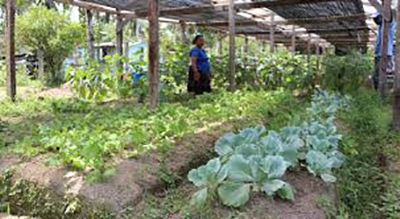WITH the newly established agriculture department in Region 10, the region is expected to reduce its dependency on outside food markets by 40 per cent by 2022, as farmers are not only gravitating to the fields, but are taking up the challenge of producing non-traditional crops.
Presently, Region 10 is sourcing 80 per cent of its food from other regions and Regional Executive Officer, Orrin Gordon, said that with strides made thus far, since the programme was implemented, the region will see a decrease in dependency for not only traditional crops, but non-traditional ones or those deemed exotic crops. These include broccoli, cauliflower, carrot, ginger and spinach. “It is a tall order but we feel we can do it and if we move from the traditional to the non-traditional, it will even be made easier,” Gordon said.

The National Agricultural Research and Extension Institute (NAREI), has been coordinating with the RDC to provide the necessary training and technical support for these farmers. Demonstration plots were set up in the various communities and many farmers are now producing the crops on their own. Regional Agricultural Officer, Dexter Collins, related that farmers are not only supplying Linden markets but out-of-town markets as well. “We see farmers now buying into these projects after these demo-plots were created and expanding their production to reach these niche markets, especially to supply the supermarket chains in Georgetown. We have one farmer from the One Mile area who is one of the main suppliers of the broccoli, cauliflower and kale to Bounty and Massy Supermarkets,” he related.
A two-year timeline was given to achieve the self-sufficiency goal because the majority of farmers are still planting to the level at which they feel comfortable, Collin’s said, while some have increased production and opened up more lands. In fact, over 300,000 acres of land have been opened up in the Intermediate Savannahs of Region 10, with the construction of the farm-to-market road from Linden to the Berbice River.
Gordon described the road as the ‘big-ticket’ project for agriculture in 2019 and while it initially catered for about two miles of road, the team was able to clear up to seven miles of road. Now the Berbice River communities as far as Sandhills, can be reached in two hours. “This dream is no longer a dream, this is a reality and the link with the Berbice River has been restored,” Gordon said.
Presently, farmers in those districts are planting thousands of acres of citrus fruits, red peas and corn, with the help of NAREI.
In addition to this farm-to-market road, farmers have been exposed to climate-smart training aimed at combating extreme weather patterns and climate change. Several farmers experienced huge losses as a result of flooding. Fourteen shade houses were established, seven of which were in secondary schools across the region, in an effort to encourage agriculture at the school level. The agriculture department is also pushing for more farmers to access agricultural loans in the region through small business financial institutions such as the Linden Enterprise Network and commercial banks.



.jpg)








